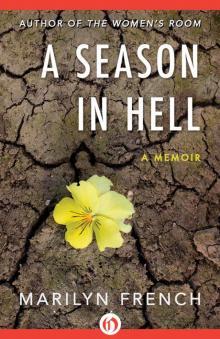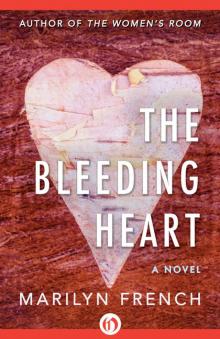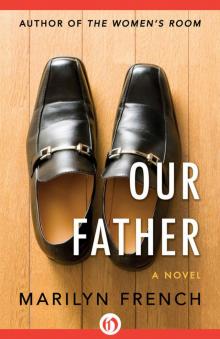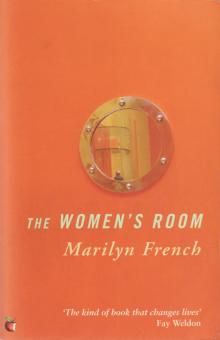- Home
- Marilyn French
The Women's Room (Virago Modern Classics)
The Women's Room (Virago Modern Classics) Read online
VIRAGO
MODERN CLASSICS
437
Marilyn French
Marilyn French was born in 1929 in New York into a family of Polish descent. She received her doctorate from Harvard University in 1972. A bestselling writer of both fiction and non-fiction her work includes The Women’s Room (1977), The Bleeding Heart (1980), Her Mother’s Daughter (1987), The War Against Women (1992), My Summer with George (1996) and A Season in Hell (1998); her illuminating memoir of her victory over cancer. Marilyn French is also a literary critic, her articles and stories appear in a wide range of journals and anthologies. She has taught at Hofstra, Harvard and the College of the Holy Cross and has received a Harvard Centennial Medal. Marilyn French died in May 2009.
Also by Marilyn French
The Book as World: James Joyce’s “Ulysses”
The Bleeding Heart
Shakespeare’s Division of Experience
Beyond Power: On Women, Men and Morals
Her Mother’s Daughter
A Season in Hell
The War Against Women
Our Father
In the Name of Friendship
My Summer with George
COPYRIGHT
Published by Hachette Digital
ISBN: 9780748132140
All characters and events in this publication, other than those clearly in the public
domain, are fictitious and any resemblance to real persons, living or dead, is purely
coincidental.
Copyright © 1977 Marilyn French
Introduction copyright © 1993 Marilyn French
Afterword copyright © 1993 Susan Faludi
All rights reserved. No part of this publication may be reproduced, stored in a
retrieval system, or transmitted, in any form or by any means, without the prior
permission in writing of the publisher.
Hachette Digital
Little, Brown Book Group
100 Victoria Embankment
London, EC4Y 0DY
www.hachette.co.uk
CONTENTS
VIRAGO MODERN CLASSICS 437
ALSO BY MARILYN FRENCH
COPYRIGHT
INTRODUCTION
CHAPTER ONE
CHAPTER TWO
CHAPTER THREE
CHAPTER FOUR
CHAPTER FIVE
CHAPTER SIX
AFTERWORD
To Isabel, to Janet – sisters, friends
INTRODUCTION
When The Women’s Room was first published in 1977, reviewers responded in outrage. That the book is now considered a classic, a given – known, digested, assimilated, no longer threatening – suggests that conditions have changed for women since 1977. And this is true. Feminist activism has generated major changes for women in law, custom, and climate. Young educated women today have opportunities that were rare or unknown to women of my generation – in educational, professional, social, and economic life. They now obtain scholarships to college, are admitted to graduate, law, and medical schools, are permitted to practise in hospitals and law firms, contract debt to buy cars or houses, and to get a telephone in their own names – something I was denied after I divorced in 1968. In other words, educated women in western countries can now choose their own lives; they are not forced into dependency on a man, as they had been for millennia. In other parts of the globe, however, women’s situation has worsened.
Women leaders have always existed, but not since Theodora in the sixth century (and she was a wife, not an elected leader) has any of them been able to change law or customs to empower women as a class. Indira Ghandi, Margaret Thatcher, and Golda Meir held office on men’s sufferance as virtual men, and could not show concern for others of their sex – if, indeed, they had any. Large numbers of women working today in business and politics are subject to the same condition. But women do voice their concerns in international politics through organisations like the Women’s Environment and Development Organization (WEDO), which pressured the male-dominated ‘Earth Summit’ – the UN Conference on Environment and Development held in Rio de Janeiro in 1992 to pay attention to female needs and approaches. Feminist activism supports women in Asia, Africa, and South America in breaking centuries-old taboos and unfair laws governing incest, rape and beatings. Women have demanded that police be retrained to treat rape, incest and beatings as crimes against women, not by them.
In 1991, a woman accused a nominee for the Supreme Court of sexual harassment; another brought charges of rape against the scion of one of America’s richest and most prominent families. Although both women were punished for their courage, their acts would have been inconceivable fifteen years earlier. Both Anita Hill and Patricia Bowman were defeated in the male courts where they were tried (for it was the women, not the men, who were really on trial), but their daring and their defeat aroused women across the United States, inspiring a new wave of feminist political involvement and new feminist organizations like WAC (the Women’s Action Coalition).
But the male response to women’s new independence has been intense, and under the pressure of male hostility, groups like WAC have become defunct or been weakened. As conservative, even reactionary, governments take power across the world, women have grown poorer than ever before. With their children, women still make up four-fifths of the very poorest people in the United States and are among the poorest classes throughout the world. Globalization promises further relegation of women to low-paid or part-time labor, while they still hold primary responsibility for unpaid rearing of the young. In addition, technological developments have made it possible to detect the sex of a fetus, which has led thousands of families in China and India, cultures which favor the male, to abort female fetuses. This has created an extreme sexual imbalance in those societies.
Religious bodies have had the most antagonistic reaction to women’s empowerment. Movements erroneously called fundamental (as if they adhered to original principles; they do not) have sprung up in Islam, Protestantism, Judaism, and Catholicism. The Catholic Church tolerated abortion for millennia before the 1970s. A newly emerged sect of Judaism aggressively advocates the settlement movement and female subservience. The primary component of Protestant fundamentalism is female subservience, opposing abortion, divorce, homosexuality, and sex outside of marriage, as well as evolution, scientific experimentation with cells, and euthanasia. However, the most widespread and aggressive of these movements is Islam, which has declared holy war against all forms of modernization – industrialization, secular education, and any form of female liberation. (For further demonstration of these claims, see my The War Against Women.)
Secular bodies oppose women’s empowerment more underhandedly. The men who run society – and it is still men who run society – are determined to halt women’s progress toward independence. The difficulty women experience in rising in corporate society, called the glass ceiling, is well known. Six men control almost all the media in the United States – book publishing, magazines, television, movie studios, newspapers, and radio. They are not friendly toward feminism, which has almost disappeared from the surface of our society. You will almost never see a feminist column on an op-ed page, a feminist article in a magazine or newspaper, actual (not satirized) feminist ideas on television or in the movies. Only magazines and radio controlled by feminists – and these are few and not well-funded – offers information on the feminist perspective.
This might be understandable if feminism were a wild-eyed manic philosophy. But it is a belief, a politics, based on one simple fact: women are human beings who matter as much as men. That is all that feminism claims. As human beings,
women have the right to control their own bodies, to walk freely in the world, to train their minds and bodies, and to love and hate at will. Only those who wish to continue to coerce women into a servant/slave class for men cannot accept this principle.
In keeping with the political climate, the conventions governing women in culture (literature, television, movies, art, and music) have regressed during the past decade. On television, women still serve men, look up to them, and possess an innate understanding of children and are expected to take care of them. With a shocking degree of frequency, they work as prostitutes. The percentage of women who are prostitutes on television is surely far greater than that in actual life; even female detectives are dressed up (or down) to act as prostitutes. The treatment of women in rap music is even more contemptuous.
Artistic conventions may seem abstract devices, but they have enormous impact. They reflect the actual subjects or approaches that are taboo in life. It was because The Women’s Room broke some literary conventions that reviewers reacted with outrage. Breaking conventions is even punished by death in certain societies. In life, conventions are rituals familiar, accepted words or actions which smooth over raw, difficult, or ceremonious occasions. We speak ’conventional’ words at funerals, at sickbeds, at weddings. In literature, conventions are formulas accepted by both author and audience as symbolizing the basic truths of their society. They are most powerful in the areas of greatest confusion and ambiguity – gender, race, and class.
Literary conventions are often unrealistic or illogical, yet audiences accept them without question. Events in Westerns, thrillers, and spy stories frequently violate both character and common sense, yet we do not demur as long as the work accomplishes its main task – to show justice triumphant. We want – and used to expect – crime dramas to conclude with a sense of final justice, with the wrongdoer dead or imprisoned and the righteous vindicated. Most important, there is no doubt about guilt. It is for this set of experiences, which is as improbable as anything else in these dramas, that the dramas exist: they agitate us by suggesting that justice might not triumph, and calm us by assuring us that it does. Indeed, when film-makers began to violate this convention, their work required a new name – film noir.
Different genres of literature are bound by different conventions, and some are more convention-bound than others. Television drama is the most conventional of dramatized forms of fiction; in books, mysteries, romance, ‘chick lit’ and ‘dick lit’ are most convention-bound. But all art is bound by convention. Audiences may not be aware of the conventions they uphold, yet react with outrage when one is broken, as in the outcry over Manet’s Le Déjeuner sur l’herbe; although nude female figures were accepted in painting, depicting two nude women with two dressed men at a picnic created a scandal. There have been outraged reactions to music – to Stravinsky’s Le Sacre du Printemps, for instance. Recently, some American congressmen and clergymen were so outraged by photographs by Robert Mapplethorpe that they tried to suppress them. A mayor of New York went so far as to shut down a subway station serving a museum that presented a picture of the Virgin by Chris Ofili, spattered with manure.
Sometimes a break in convention is accepted as refreshing. Decades ago a spy novel by a new author showed the entire network of spydom to be shoddy, inhuman, and deceitful; instead of the traditional picture of our good guys and their bad guys, both sides were shown as tainted. Audiences accepted this vision because they had come to see government and power as suspect.
Literature dealing with women is still very convention-bound and extremely resistant to change. Traditional ‘women’s’ books deal with young unmarried women. The action is her choosing of a husband, the only choice she has the power to make and the final choice of her life such books always end with her marriage. The crisis involves the risk of choosing the wrong man (the reader always knows he is the wrong man), being too proud and stubborn to choose any man at all, or a threat to her virginity or her reputation for virginity (which were equally serious threats). Even the great writers about women – Jane Austen, Fanny Burney, Charlotte Brontë, Elizabeth Gaskell, George Sand, George Eliot, Henry James, Edith Wharton, and Virginia Woolf, among others – were unable to break the convention of chastity. Good women were virgins when they married, and faithful within marriage – although good men like Tom Jones were permitted a bountiful variety of healthy lust. The heroine’s hymen was the hinge of the plot. Needless to say, that hinge always held. Although Sand lived in sexual freedom, Eliot lived with a married man, Wharton had a love affair outside marriage, and Woolf had female lovers as well as a husband, none but Wharton even hinted at similar arrangements in her work.
Even after women began to move into public careers, writers about women could not overcome the convention that a woman must choose between a career and love-and-marriage. Although Charlotte Brontë worked all her life and presumably would have gone on writing after her marriage if she had not died; although Sand, Gaskell, Eliot and Woolf had productive careers along with marital or semi-marital arrangements, their experience was too atypical for them to be able to depict it as available to most women. Even Henry James’s remarkable Henrietta Stackpole gives up her career for a husband.
The cowboy’s choice of horse and open trail over the yearning blonde in a high-necked gingham dress was no less inevitable than the affirmation of true love for women. Men were – and are still – being told that true manhood consists of freedom, work, adventure, and isolation; women were – and are still – being told that true happiness resides in love, shown as sexual attraction that endures. Thus, conventions are not mere devices: they are expressions of moral and political laws.
In the fifties and sixties, films about women – when there were any – occasionally entered the troublesome area of sexual freedom for women, depicting sympathetic women who did not remain utterly virginal or faithful. But one knew that as inevitably as a private eye would lose his dream woman to a murderer’s bullet or a jail sentence – and thus be able to return, accompanied by the wail of a lonely clarinet, to his cheap apartment, his bottle of booze, and his lonely isolation – the sympathetic sexual woman would be dead by the end of the film, often killed in an accident caused by her own hysteria or remorse. Much as we might like Elizabeth Taylor or Simone Signoret, a higher justice was operating.
While some conventions, like the demand for sexual ‘purity’, have eased, many remain. Convention has always held women’s work – what is still called women’s work – illegitimate as subject matter for serious literature: one could describe ruined casseroles or erupting washing machines or screaming children only as the comic frustrations of a wry, witty ‘mad housewife’. Christina Stead’s magnificent and still insufficiently read The Man Who Loved Children depicts actual domestic drudgery by the tormented, pathetic Henny: but that book took twenty-five years to reach a substantial audience, and survived only by word-of-mouth passed by women’s networks. And it is still savaged by male critics. Although novels like Stead’s, and Doris Lessing’s great The Golden Notebook and, later, The Women’s Room treat women’s work seriously, the subject still consigns a work to less than serious status in the eyes of literary critics. To put it another way: under no circumstances may the actual daily occupation of half of the world’s population be taken seriously.
Most women, whether living alone or with others, have all or most of the responsibility for creating and maintaining a felicitous living place, for doing work that ranges from utter drudgery to sensitive psychological examination and highly creative invention. ‘Women’s work’ takes up much of the lives of almost all the women in the world. Indeed, it is the most important single work in the world. Without it, all other endeavors would falter; children and men would die or go mad, the world would be emotionally barren. In places where ‘women’s work’ includes farming, the people would starve without it – yet even here, men treat it as without value.
We must question why women’s work is universally trivialized. L
iterary conventions are not mere technical devices; they are expressions of cultural laws. That women’s work is elided or trivialized in literature is directly related to the fact that this work is unpaid. Women comprise, in fact, a huge slave labor force throughout the world. To suggest that their work is important would undermine this economic arrangement. People who believe they are doing important, even essential, work demand appropriate payment.
Further, that women are not paid for their work in a world that values money and worldly power above anything else, suggests that women are unworthy of respect. Thus, men can ignore the world view women develop in the course of lives spent taking care of others – children, men, the sick, friends, relatives. Men can complacently continue to exalt rationality, power, possession, and hierarchy, and to justify domination as a necessary and natural principle, unhampered by the criticism of women or men who entertain a different value system. Men in power do not even hear radical criticism because they have pre-labeled it invalid, soft-headed, or insane. Because the dominant class controls the discourse, only the independently thoughtful even perceive the insanity of our present culture.
The Women’s Room broke another convention, one which has eroded further because of feminism and the emergence of wonderful lesbian novels. This is the idea that men are central to women’s lives. As long as a novelist observes this convention, no one will object to the fact that all the men in the novel are repulsive, hollow, selfish, or wooden. Male character is less important than male centrality. In a male-centered novel, the heroine clearly needs a man; whatever her fate, the male reader does not feel threatened since he knows she could be happy if only she had the love of a good man – one very like himself. (In an interesting sidenote to this, film depictions of Edith Wharton’s The House of Mirth invariably show Selden as emotionally present and available – only somehow not at the moment – to Lily. This mocks the conclusion of the novel, and undermines Wharton’s point. If Selden were willing to marry Lily, she would not have to commit suicide. But filmmakers cannot bear to depict a male refusing to be a ‘hero’.)

 A Season in Hell
A Season in Hell My Summer With George
My Summer With George The Bleeding Heart
The Bleeding Heart Our Father
Our Father The Women's Room
The Women's Room The Women's Room (Virago Modern Classics)
The Women's Room (Virago Modern Classics)